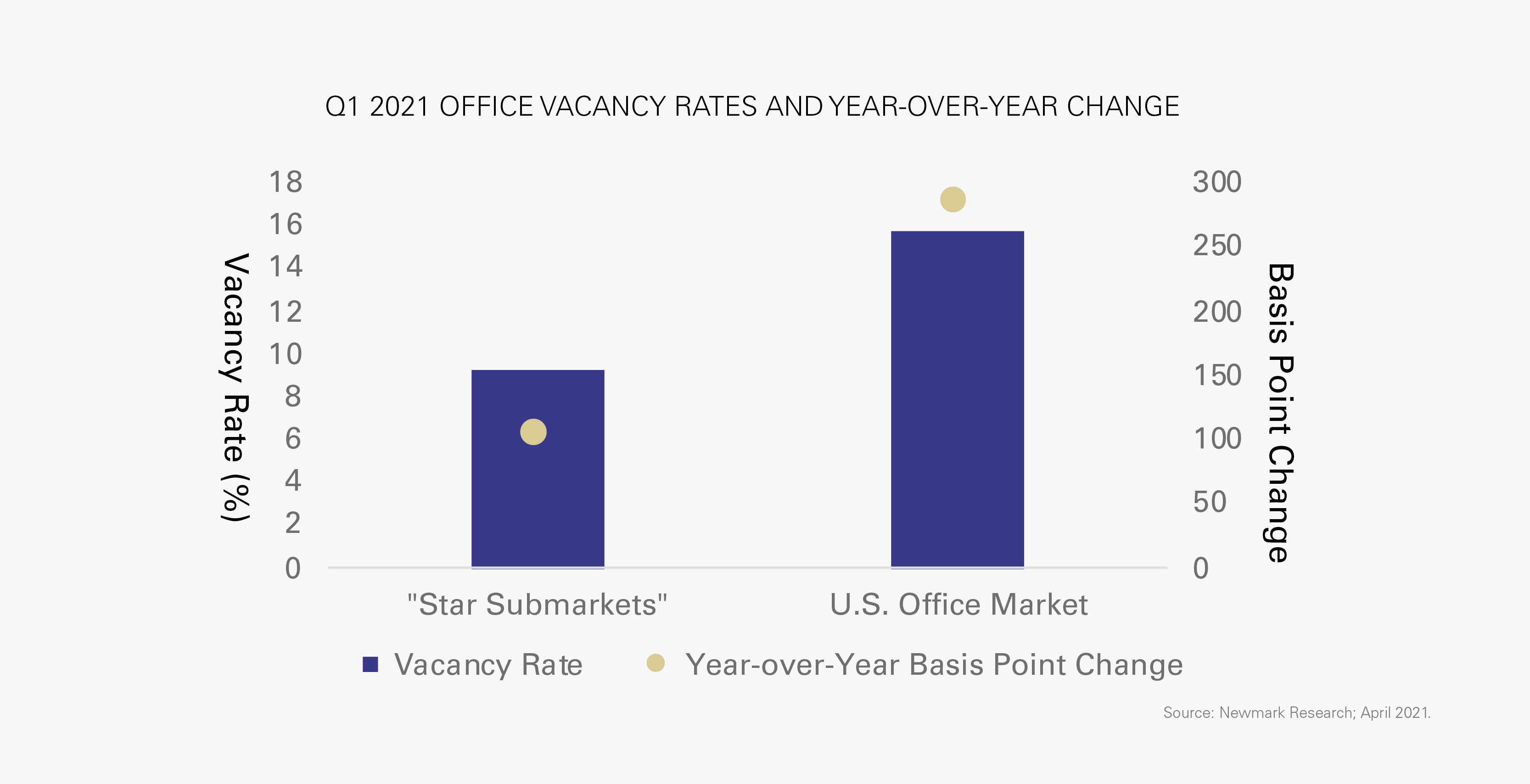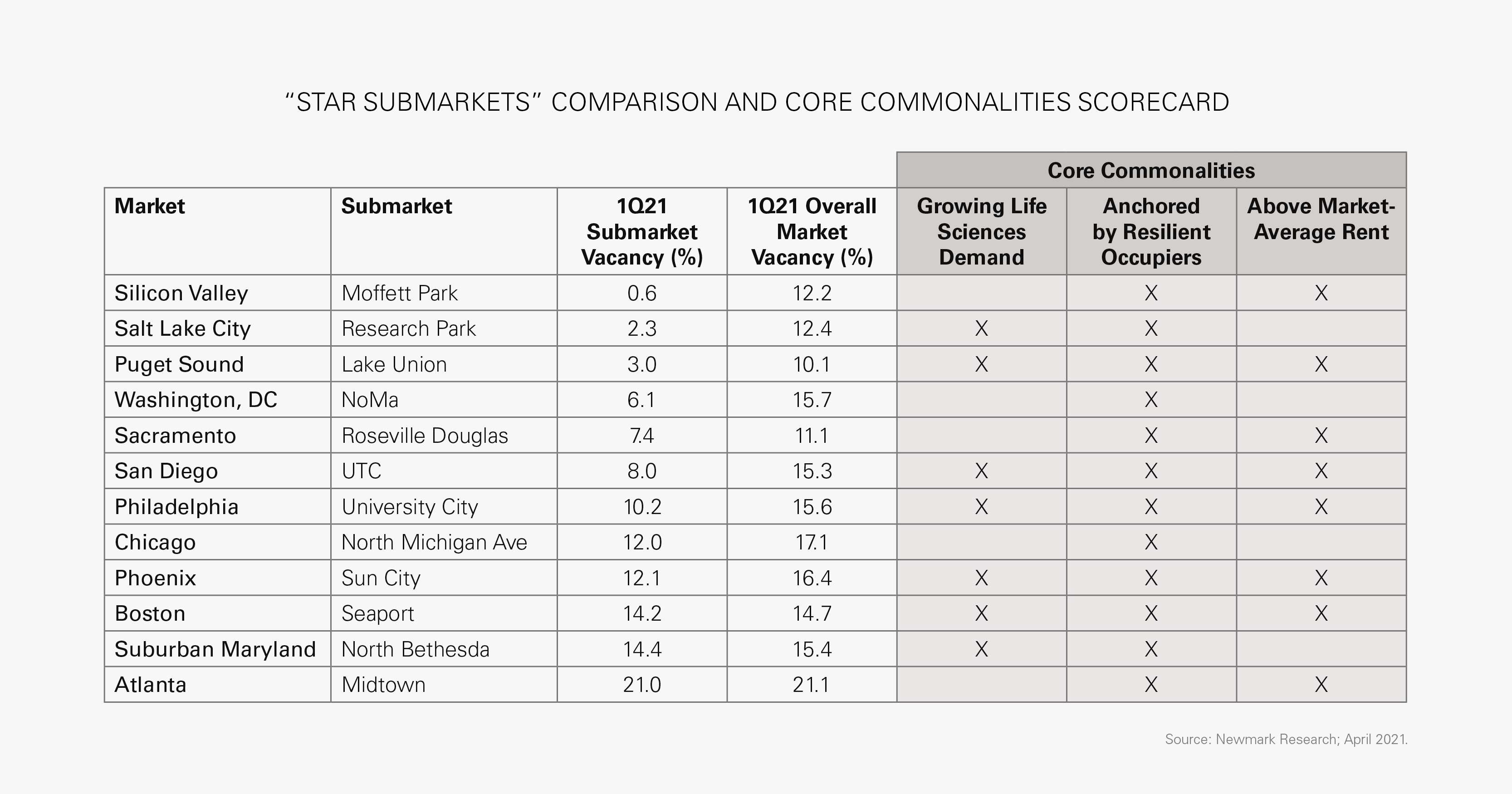The National Trend: “Star Submarkets” Feature Common Denominators
The first quarter of 2021 marked a year since the office sector was
upended due to COVID-19, a year in which each of the 56 U.S. office
markets tracked by Newmark Research realized an increase in vacancy on
the heels of economic turbulence and persistent remote-work strategies.
Most of these metro areas endured a deterioration in fundamentals
throughout the region, but not all: 12 metro area markets reported “star
submarkets” that typically exhibited more favorable vacancy trends,
lower increases in sublease space, and stronger rent performance as
compared to their peer submarkets. In some cases, those star submarkets
did not just remain stable but flourished despite the considerable
headwinds generated by the pandemic. Analysis of these disparate pockets
of office properties revealed certain commonalities that, while not
panaceas for all of the risks and challenges facing the office sector as
a whole, nonetheless emerged as key stabilizers. Those core
commonalities of “star submarkets” include:
- Growing demand from life sciences firms.
- Being anchored by educational and health institutions, or mature tech firms such as Facebook, Apple, Amazon, Netflix and Google (FAANG).
- Boasting a
long-demonstrated appeal due to their confluence of quality space, prime
location, and accessibility. Such appeal is generally reflected in
average asking rents higher than the overall market average and lower
vacancy rates. The first figure shows the 650-basis-point gap between
the lower vacancy rate of these outperforming submarkets and the higher
average rate of the broader U.S. office market.

The fight against COVID-19 shined a global spotlight on the life
sciences industry, but prior to the health crisis, the overall narrative
of a dynamic, growing industry was already catalyzing record investment
into the sector and consequently driving increased demand for
specialized commercial space. In many established and emerging life
sciences clusters around the country, life sciences leasing has not lost
momentum since the pandemic began, and in some leasing has accelerated.
Seven of the 12 “star submarkets” shown in the second figure are
experiencing growing demand from this industry. The distinction between
submarkets with growing life sciences demand and the most mature
epicenters is also telling—Boston’s most resilient office submarket
right now is not Cambridge, its premier life sciences submarket, but
rather Seaport, where increased demand for lab space has helped
stabilize office fundamentals. Demand has increased, and vacant,
competitive office space is being removed from the inventory and
converted to lab space to accommodate tenant demand.

Portions of an office market with a vibrant concentration of
education and health institutions (“eds & meds”) or the Big Five
tech firms were also more likely to outperform surrounding submarkets.
Eds & meds have struggled with the financial toll and disruption
wreaked by the pandemic but remain among the most recession-resistant
industries. Furthermore, eds & meds institutions tend to think of a
commercial footprint in terms of a master development plan that may span
decades; compared to the uncertain life cycle of companies in more
volatile industries, an eds & meds concentration anchoring a
submarket can more reliably yield stability. Eds & meds is driving
demand in some “star submarkets” and helping to buttress others. For
example, San Diego’s UTC submarket has experienced strong demand from
healthcare due to its proximity to UC San Diego’s campus and its
associated medical and research facilities; in Chicago, the most
resilient submarket, North Michigan Avenue, is home to two of Chicago’s
main hospital groups and several Northwestern University campuses.
The tech industry has been a significant driver of weakening
fundamentals across the office landscape—a software coder does not
require a specialized built-environment in which to work—yet the largest
companies in tech, FAANG firms, have all continued to lease space
throughout the pandemic, bolstering demand in office markets across the
country. Submarkets anchored by FAANG, such as Silicon Valley’s Moffett
Park or Puget Sound’s Lake Union, have seen barely any budge in
single-digit vacancy rates during the past year. All 12 of the select
“star submarkets” reported a concentration of resilient occupiers in the
eds & meds or FAANG categories, or they are bolstered by government
occupancy. Boasting a resilient industry is perhaps the most critical
factor in a submarket outperforming during the pandemic-induced
downturn.
The final core commonality among the “star submarkets” is more
general, but exceptionally fundamental. In every market, there are the
haves and the have-nots: submarkets that are prized by tenants seeking
quality space with an amenity-rich, easily-accessible location, and
submarkets that offer more cost-conscious options, often at the expense
of these benefits. As such, desirable submarkets tend to carry with them
a higher cost of entry than the overall average market rate. There is a
fine line to this, as tenant migration away from the highest-end rent
districts has been occurring for some markets during the pandemic. Yet
across the board, higher-quality space in a prime submarket remains more
attractive to tenants than lesser-quality space. Eight of the 12 “star
submarkets” posted above-average rents in the first quarter of 2021.
Featured Submarket: Philadelphia’s University City
University City, located in Philadelphia’s Central Business District, has emerged as a “star submarket” in the past year. Already a popular office and lab destination in the Philadelphia region, it has experienced strong demand and rent growth, negligible increases in sublease availabilities, and an increase in preleased development during the past 12 months. Its world-class concentration of eds & meds has not just stabilized the submarket during this period of economic turmoil but is at the heart of the submarket’s expanding life sciences demand, especially in the cutting-edge fields of gene and cell therapy. Of the 341 identified gene therapy trials active in the U.S. in 2019, more than 280 were sponsored by hospitals, universities and the National Institutes of Health. This signals a deepening of a trend that University City has pioneered: cell and gene therapy startups spinning out of the academic and medical institutions that foster them, and taking commercial space in a growing, proximate cluster. Due to a dearth of competitive space, plus sustained and elevated demand, the average asking rent in University City grew 4.3% over the past year to $42.05/SF, which is the second-highest average asking rent in the Philadelphia market.
What Are the Implications for Our Clients?
Investment in office assets is slowly but steadily rebounding as the pandemic lessens its grip on the country. For cautious investors, taking into consideration the core commonalities of submarkets that have withstood the economic storm, and using such considerations to guide investment decisions, may mitigate risk to future asset values.
Many office occupiers located in “star submarkets,” whether those identified in this report or otherwise perennially popular office destinations in a given market, will be reassessing workplace strategy and company budgets in 2021. Those considering a reduction in office space may wish to consider the cost of underestimating space needs in the short term, only to experience a potentially higher-cost landscape when re-engaging with the market in the future.
Sources: Newmark Research, JAMA Network Open, Real Capital Analytics

















